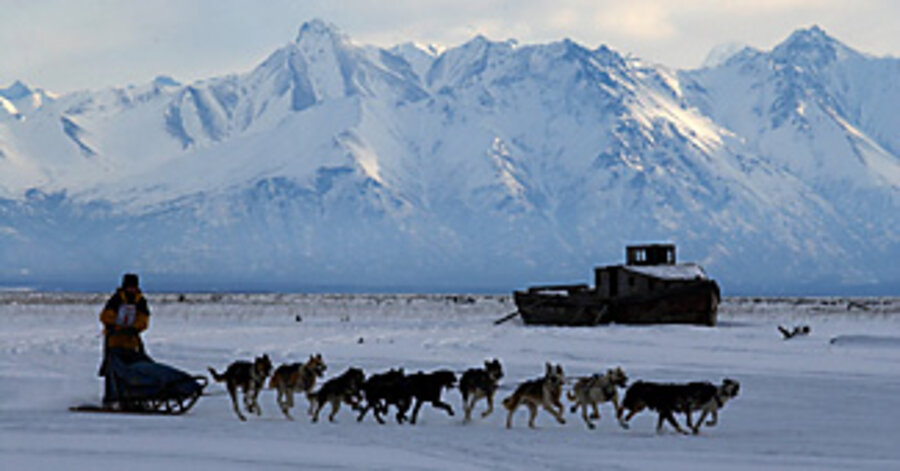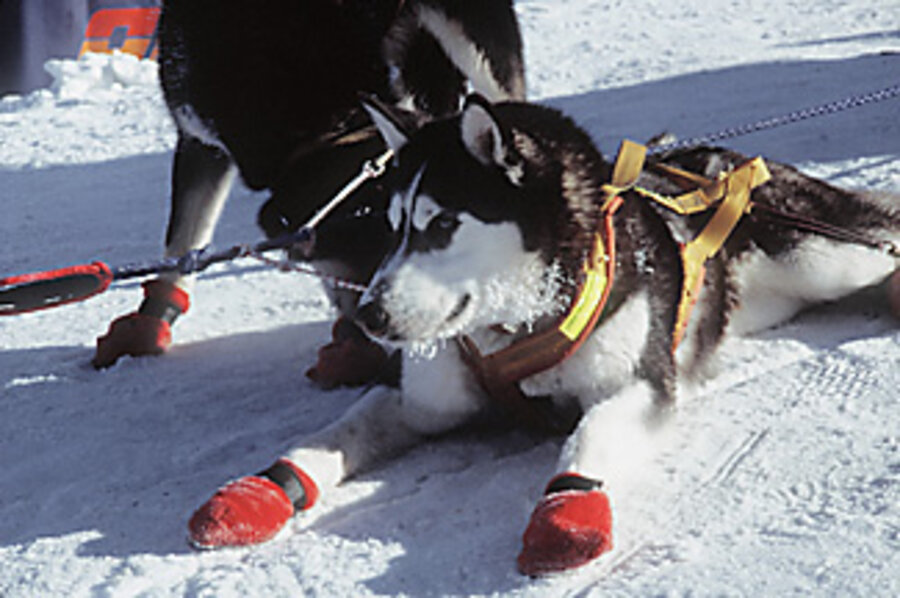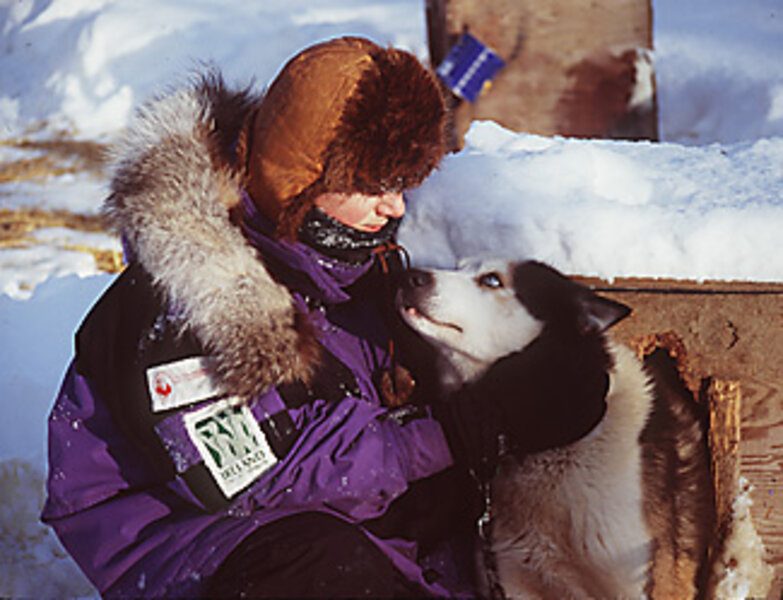Teens, their dogs, and an amazing race
Loading...
| Wasilla, Alaska
Ice cracks beneath the weight of dozens of pickup trucks, sending a warning: Drive slowly on frozen Knik Lake. It's a frostbite kind of morning in February 2007. The thermometer dips to 20 degrees below zero – that's Fahrenheit, without a wind chill factor.
The howls of Alaskan huskies slice the air. Male and female mushers between the ages of 14 and 17 wearing down parkas with thick fur ruffs and insulated gloves unload their teams from "dog boxes." These camperlike shells fit snugly on the beds of trucks.
The mushers are getting ready to start the 30th Jr. Iditarod Trail Sled Dog Race. They toss chunks of fish and sausage on the ice-encrusted ground as a prerace doggy snack. They check their sleds to make sure they haven't forgotten anything: ax, snowshoes, headlamp and an alternate battery-powered light, cold-weather sleeping bag, and a lighter or matches to start a fire.
Among other things, rules also require dog food, a dog-food cooker, and eight dog booties (snug-fitting, socklike coverings) for each dog. Additionally, all dogs entered must have a physical exam no later than 14 days before the race start. Dogs must also have up-to-date shots.
A race official checks everything off. "Good luck," he says, knowing that these teens will rely more on their training than on good fortune. Most of them have spent the winter mushing in shorter sprint races to prepare for this one. Some have been involved in the sport since they were 4 or 5 years old racing in single-dog events.
The two Iditarods
The two-day Jr. Iditarod began in 1978 as a way to let young mushers compete in a shorter version of the grown-up Iditarod.
The junior route is approximately 150 miles, which is much shorter than the 1,049-mile route that adult racers follow from Anchorage to Nome, Alaska.
The adult Iditarod honors the 1925 serum run when 20 mushers and about 150 hard-driving huskies rushed to transport medicine from Nenana to Nome, Alaska, in just 5-1/2 days. Back then, the 674-mile journey usually took 25 days by dog sled.
During the late 1800s and early 1900s, sled-dog teams transported mail, supplies, and people. Later, airplanes took over the mail routes. And snowmobiles eventually sped onto the scene, pushing the tradition of dog sledding closer to extinction.
The adult Iditarod was organized in 1973 by mushing enthusiasts to help keep this part of Alaskan culture alive. Dog mushing is now the official state sport.
Hit the trail
At the 2007 junior race, the teen mushers slip padded harnesses over each canine. The main lines, called "ganglines," run through the center of the teams. Race rules require a minimum of seven dogs per team and a maximum of 10. The mushers kiss their dogs and give them a friendly scratch. "Ready to go, fella?" they ask.
Then they slip booties onto the dogs' paws to protect toe pads from snow and ice. Booties that start to slip or that develop holes are quickly adjusted or changed. Every musher knows the saying: "A dog team is only as good as its feet."
The bone-chilling cold doesn't keep family, friends, and reporters from hanging around the starting chute. An official announces mushers' names over loudspeakers as teams are released at two-minute intervals.
"Veteran Patrick Mackey from Kasilof!" the announcer says.
Spectators cheer as the dogs take off and numbered racing bibs fade into the snowy white wilderness.
Balanced on sled runners hour after hour, mushers grip the handlebars in the face of wind-driven snow. They shift their weight as they maneuver sleds around gullies, boulders, and trees. Sometimes, they even jog behind the sled to keep warm.
Verbal commands ring out: "Gee!" and "Haw!" The terms translate into right and left turns. Dog names like "Blackie" and "Lucky Lady" cause canine ears to prick up.
During most of the race, the wilderness is silent except for the whooshing of sled runners.
In deep snow, dog teams look as though they're "swimming" down the trail. On hard, well-packed sections of trail, a musher works to keep his team down to 10 or 12 m.p.h. He wouldn't want his dogs to tire out because they've been running too fast. Pacing is everything.
Still, mushers know there's no such thing as a foolproof race plan. All strategies must be as flexible as the constantly changing terrain and weather conditions.
Pit stop
Hours slip by. Snow falls. Visibility is near zero. It's time to "snack" the dogs with bite-size chunks of raw meat or "ends and pieces" of bacon. Patrick Mackey, who also participated in the 2006 Jr. Iditarod, replaces tattered booties with new ones from his sled. His dogs' booties are handmade by friends and family. He untangles a twisted line.
Besides caring for their dogs, mushers also grab snacks for themselves. Trail mix and "honey balls" are favorites. (These sticky treats are made from a mixture of crunchy peanut butter, honey, chocolate chips, oatmeal, and Carnation Instant Breakfast mix that's rolled into balls, then sprinkled with coconut.)
Dogs get "honey balls," too, but theirs are made with hamburger, honey, and vitamin supplements.
On the run
The straightaways on Yentna River seem to go on forever. One year, a rookie fell asleep while standing up. Tumbling off a sled is an instant wake-up call. So is hustling after a dog team in knee-high snow after falling!
Sometimes mushers get lost in the expanse of white, zigzagging until they find a stake marking the route. Lost hours are gone forever, and it's hard to catch up after that.
As darkness creeps down the trail, headlamps light the way. Temperatures dip lower. Cold numbs everything except the dogs, who are bred for the Alaskan weather. Snow flies off their booties, and their tails curl over their backs.
A good night's rest
The first team arrives at the halfway point, Yentna Station Roadhouse, approximately 75 miles from the race's start. There isn't any running water or electricity – only generator-powered lights.
Earlier, a veterinarian, ham-radio operator, race official, and journalist were flown to the roadhouse in a bush plane.
The veterinarian greets each team and checks to make sure the dogs are OK. The race official enters arrival times, marking the start of a required 10-hour layover.
The mushers spread straw on the ground for their dogs and check their furry friends' feet.
Then, it's dinner time. It takes a heap of snow to yield enough water to fill the dog-food cooker. Heating fuel carried in the sleds keeps the blue flame high, and frozen food thaws quickly when dropped into hot water. The dogs' meal is full of fat and protein: beef, lamb, turkey, chicken, or liver – and sometimes, beaver, moose, caribou, or seal meat!
Mushers repair damaged equipment by the light of their headlamps. And they toss their sleeping bags on straw beside their teams for a short winter's nap.
All too soon, the alarm buzzes. After feeding and watering the team, checking its ganglines, and repacking the sled, the first musher is ready. "Let's go!" rings out.
Winner's circle
Mushers cross the finish line at Willow Community Center in Willow, Alaska.
A banquet follows the race where scholarships, trophies, and special awards are handed out for sportsmanship, rookie of the year, the best lead dog, and the best- cared-for team (chosen by the race's veterinarians). Even the last musher to finish gets recognition with the Red Lantern Award.
The winner and his or her parents receive round-trip tickets to Nome, where the Jr. Iditarod championship trophy is presented. No matter where they finish in the race, the competitors can feel proud that they've gone the distance and helped carry on Alaska's mushing tradition.
Competitive sled races – a good idea or not?
Long races with dogs through harsh weather are controversial. Animal rights groups such as the Humane Society of the United States (HSUS) object to them.
"We don't oppose recreational mushing," says HSUS spokesperson Kelly Connolly, "as long as the dogs are well cared for. But we are opposed to any sort of competitive race that's strictly entertainment and done for profit only.
"We're concerned with the welfare of the dogs," Ms. Connolly adds.
According to the HSUS website, the regular Iditarod for adults "forces the dogs to run too far and too fast in frequently grueling trail and weather conditions, and it exacts a severe, and sometimes fatal, toll on dogs' physical and psychological systems."
Ms. Connolly says that the same objections apply to the shorter race by teens.
"While the ITC (Iditarod Trail Committee) has made some reforms in recent years ... race organizers continue to mass-market the race and hype the competition among mushers who are continually attempting to break speed records," the website adds.
The Iditarod Trail Committee disagrees with this assessment of the races it oversees. "The Jr. Iditarod Sled Dog Race provides youth an environment where they can learn about the traditional values that embrace the special bond between the working canine athlete and the human athlete," it says in a statement.
"A Jr. Iditarod musher learns how to apply animal-care skill sets that range from medical to nutritional applications in order to ensure that the team arrives at the finish line healthy. These ... are the cornerstones of the Iditarod Trail Sled Dog Race."







